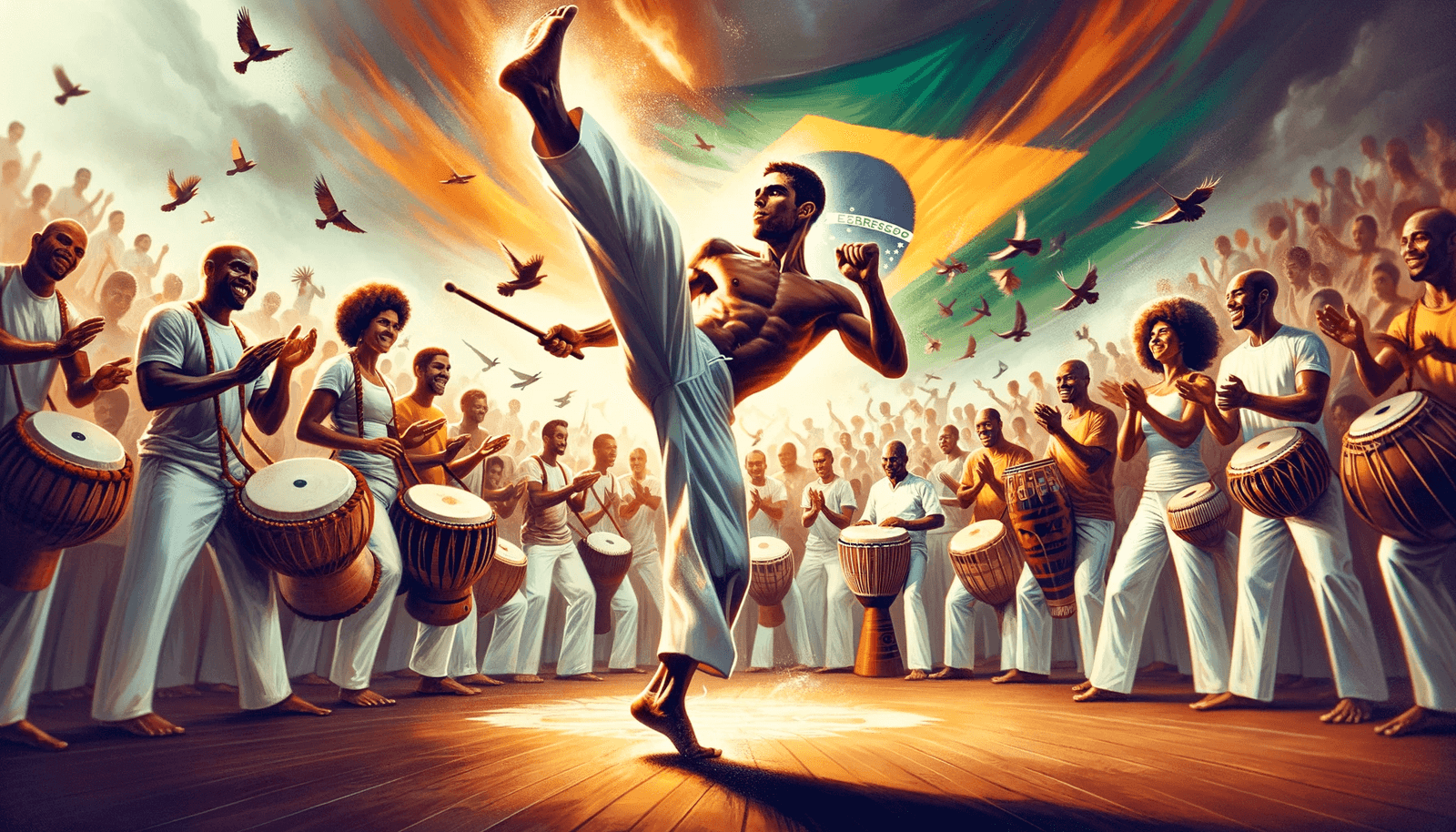Discover Traditional Brazilian Music through 20 essential artists and their unforgettable songs.
Key Takeaways:
- Insight into Brazil’s diverse cultural heritage.
- Overview of 20 iconic Brazilian musicians and their most famous tracks.
- Exploration of genres from Bossa Nova to Samba, showcasing Brazil’s rich musical landscape.
Brazilian music is a reflection of the country’s diverse cultural heritage, blending Indigenous, African, and Portuguese influences to create a unique sound that resonates globally.
From the melancholic tunes of Bossa Nova to the vibrant beats of Samba, and the heartfelt narratives of MPB (Música Popular Brasileira), traditional Brazilian music offers a window into the nation’s soul, telling stories of love, resilience, joy, and social change.
These artists, though they may not dominate today’s top charts dominated by pop and “TikTok songs”, but are fundamental to understanding Brazil’s musical identity.
20 song and artists of Traditional Brazilian Music
Mas, Que Nada! – Jorge Ben
Released in the 60s, this track became an anthem of the samba rock genre, showcasing Jorge Ben’s genius in blending samba with jazz, funk, and rock influences.
The phrase “Mas, que nada!” translates roughly to “Oh, come on!” or “No way!”, capturing the Brazilian way of dismissing worries and diving into the joy of life.
This song invites listeners to let go of their troubles and dance to the infectious beat of optimism. It’s not just a song; it’s a cultural invitation to experience the warmth, the rhythm, and the undeniable charm of Brazil.
Jorge Ben’s masterpiece has crossed borders, covered by artists worldwide, including the famous version by Sergio Mendes & The Black Eyed Peas, making it a timeless piece that introduces the global audience to the richness of Brazilian music.
Aquele Abraço – Gilberto Gil
Released in 1969, during a period of intense political turmoil in Brazil due to the military dictatorship, this song became a symbol of resilience, hope, and the unbreakable spirit of the Brazilian people.
Gilberto Gil, one of the pioneers of the Tropicália movement, infused “Aquele Abraço” with his distinctive blend of samba, rock, and bossa nova, creating a sound that’s both uniquely Brazilian and universally appealing.
The title translates to “That Hug,” and the song references various cultural and iconic landmarks of Rio de Janeiro, celebrating the city’s beauty and vibrancy despite the challenges of the era.
Plan your trip to Brazil
- Find the cheapest flights
- Discover the best accommodation
- Explore this incredible country with the best experiences
- Stay connected at all times with an eSIM
Sozinho – Caetano Veloso
Though originally penned by Peninha, it was Caetano’s rendition, released in the late ’90s, that etched this song into the collective heart of Brazil and beyond.
This ballad speaks of love and longing with a simplicity and depth that resonate deeply with anyone who’s ever felt the pangs of solitude.
Veloso, a master of the MPB (Música Popular Brasileira) genre and a key figure in the Tropicália movement, lends his tender, emotive voice to the lyrics, turning “Sozinho” into a universal anthem of the human condition.
“Sozinho” (which translates to “Alone”) captures the bittersweet essence of longing and the universal search for connection.
Construção – Chico Buarque
Released in 1971, during the height of Brazil’s military dictatorship, this song is a masterclass in storytelling and musical innovation.
Chico Buarque uses the samba genre not just for its rhythmic allure but as a vessel to deliver a powerful critique of the dehumanizing effects of urban society and the alienation of the working class.
The song tells the story of a construction worker’s tragic death, using complex lyrical structure and shifting perspectives to emphasize the cyclical and oppressive nature of labor under capitalism.
Each verse ends with the same haunting line, “E o mundo se despedaçando ao redor,” which translates to “And the world falling apart around him,” highlighting the individual’s struggle amidst societal collapse.
“Construção” is a brilliant example of how Brazilian artists have historically intertwined music with political and social critique, offering a mirror to society’s most pressing issues.
Chico Buarque, known for his eloquent protest songs, invites listeners to look beyond the surface of Brazil’s vibrant culture to understand the struggles and resilience of its people.
Emoções – Roberto Carlos
Released in the early 1980s, this song quickly became one of the anthems of Roberto Carlos’ illustrious career, a career that has made him a beloved figure not just in Brazil, but around the world.
Known as the “King of Latin Music,” Roberto Carlos has a knack for capturing the complexity of human emotions in his lyrics, and “Emoções” is perhaps one of his finest examples.
The song opens with the lines, “When I feel the beauty of a sincere emotion,” setting the stage for a journey through the highs and lows of human feelings. It’s a testament to the power of love and the deep connections we forge with others.
Roberto Carlos’ smooth voice, coupled with lush orchestration, creates an almost ethereal atmosphere, inviting listeners to reflect on their own experiences of love, loss, and the myriad emotions that define our humanity.
In Brazil, where music is an integral part of the cultural fabric, this song has touched the hearts of millions, becoming a staple in romantic playlists and a favorite for special occasions.
Deixa a Vida Me Levar – Zeca Pagodinho
“Deixa a Vida Me Levar” by Zeca Pagodinho is a samba that embodies the Brazilian philosophy of life, capturing the essence of a carefree and optimistic approach to living.
Released in the early 2000s, this song became an anthem for those who choose to live life one day at a time, embracing joy and challenges alike with open arms.
Zeca Pagodinho, a figure synonymous with the revitalization of traditional samba in contemporary Brazil, delivers this message with his characteristic warmth and charisma.
Asa Branca – Luiz Gonzaga
Released in 1947, this classic embodies the struggles and dreams of the sertanejo (the people of the Brazilian hinterlands), painting a vivid picture of life in the arid landscapes of the Northeast.
Luiz Gonzaga, known as the “King of Baião,” uses the accordion, zabumba, and triangle to create a sound that is quintessentially northeastern, bringing the stories and soul of his people to the forefront.
The song tells the story of a drought so severe that even the white-winged “asa branca” (a type of pigeon) flies away, a metaphor for the despair and displacement felt by many during these harsh times.
Yet, the song is imbued with a sense of hope, a promise of return when the rains transform the dry lands once more.
Evidências – Xitãozinho e Xororó
Released in 1990, this ballad transcends the sertanejo genre to become a universal anthem of love, longing, and undeniable truth.
Xitãozinho e Xororó, a duo that has shaped the sound of Brazilian country music for decades, delivers this song with such emotion and sincerity that it’s impossible not to feel every word.
The song speaks of undeniable evidence of love, despite attempts to deny it, capturing the universal experience of trying to hide one’s true feelings only to realize that love cannot be concealed.
The chorus, powerful and resonant, has been sung by countless fans across Brazil and beyond, often becoming the highlight of the duo’s live performances.
“Evidências” is more than just a song; it’s a cultural phenomenon, a piece of the collective Brazilian soul expressed through music.
Wherever you go in Brazil, if you start singing the chorus of this song, one or more people will help you finish it.
Canção da América – Milton Nascimento
“Canção da América” by Milton Nascimento is a heartfelt ode to friendship that resonates deeply within the Brazilian soul and beyond.
Released in 1980, this song quickly became one of Nascimento’s most beloved tracks, celebrated for its poignant lyrics and the warmth of its melody.
Milton Nascimento, a figure of immense importance in Brazilian music, known for his unique voice and innovative compositions, here offers a message of unity and eternal bonds that transcends time and distance.
The lyrics, “Amigo é coisa para se guardar / Debaixo de sete chaves / Dentro do coração,” which translates to “A friend is something to keep / Under seven locks / Inside the heart,” beautifully express the value and depth of true friendship.
The song’s universal appeal lies in its ability to touch upon a fundamental human experience—the deep connections we share with those we consider true friends.
Como Nossos Pais – Elis Regina
Originally written by Belchior, it was Elis Regina’s rendition in the mid-1970s that truly captured the hearts and minds of Brazilians, embedding the song deeply into the cultural fabric of the country.
Her powerful and emotive delivery elevates the song’s poignant lyrics, which contemplate the complexities of growing up and the realization that we are not so different from our parents, despite our youthful aspirations to break from tradition.
“Como Nossos Pais” is no exception, serving as a mirror to the societal shifts and cultural tensions of the time. It speaks to the universal experience of coming of age, the desire for change, and the eventual understanding of life’s cyclical nature.
Não Deixe o Samba Morrer – Alcione
Released in the mid-1970s, this song became an anthem for the resilience of Brazilian culture and the enduring spirit of its most iconic musical expression.
Alcione, known as the “Marrom” (Brownie) for her powerful voice and commanding presence, delivers this song with a passion and depth that only she can.
Her rendition is not just a performance; it’s a heartfelt plea to keep the tradition of samba alive, vibrant, and evolving.
The song’s lyrics speak to the importance of samba not just as a musical genre, but as a cultural identity, reflecting the joy, sorrow, and soul of the Brazilian people.
“Não Deixe o Samba Morrer” became more than a song; it became a movement, inspiring new generations to embrace and contribute to the samba legacy.
Alcione’s powerful interpretation has turned this track into a timeless classic, embodying the spirit of Brazilian resilience and creativity.
Gostava Tanto de Você – Tim Maia
Released in the mid-1970s, this song showcases Tim Maia’s powerful voice and his unique ability to blend Brazilian music with soul, funk, and R&B influences from the United States.
Known as the pioneer of soul music in Brazil, Tim Maia brought a new depth and richness to the country’s musical landscape, and “Gostava Tanto de Você” is a testament to his emotional depth and musical genius.
The song’s title translates to “I Loved You So Much,” and its lyrics speak of deep longing and the pain of lost love, themes that resonate universally.
Maia’s passionate delivery and the song’s lush arrangements create a deeply moving experience, showcasing his talent for conveying complex emotions through music.
“Gostava Tanto de Você” has become a classic, enduring through the years as a favorite among fans of all ages, and serving as a powerful reminder of Tim Maia’s legacy as one of Brazil’s most influential musicians.
Festa do Interior – Gal Costa
Released in 1981 as part of the album “Fantasia,” this song quickly became a hit, thanks to its lively melody, infectious rhythm, and Gal Costa’s captivating vocals.
Known for her versatility and ability to traverse various Brazilian music genres, Costa shines in this forró-inspired track, bringing the spirit of Brazil’s interior festivities to life.
The song evokes images of communal gatherings, where music, dance, and the warmth of human connections transform the simplicity of rural life into something magical and extraordinary.
“Festa do Interior” invites listeners to let go of their urban preoccupations and immerse themselves in the celebratory atmosphere of the countryside, where the rhythms of forró and samba de roda reign supreme.
Gal Costa’s rendition of “Festa do Interior” is a testament to the rich tapestry of Brazilian music, highlighting the cultural diversity and regional influences that shape the country’s musical landscape.
O Mundo é Um Moinho – Cartola
Released in the 1970s, this song showcases Cartola’s profound lyricism and melodic genius, making it one of the most revered classics in Brazilian music.
Cartola, a legendary figure in the samba genre and one of the founders of the Estação Primeira de Mangueira samba school, lived a life that was as poetic as his songs.
His works reflect a blend of personal struggles and profound observations about life, love, and fate.
“O Mundo é Um Moinho” translates to “The World is a Windmill,” suggesting the idea that life’s challenges and adversities are like relentless millstones, grinding down everything in their path.
Garota de Ipanema – Tom Jobim
Written by Antonio Carlos Jobim with lyrics by Vinícius de Moraes, this song tells the story of a young beauty walking by the Ipanema beach, capturing the allure and laid-back elegance of Rio de Janeiro’s beach culture.
Since its release in the early 1960s, “Garota de Ipanema” has been covered by artists worldwide, becoming one of the most recorded songs in music history.
Tom Jobim, a master composer and pianist, is hailed as one of the key figures in the development of bossa nova, a genre that blends samba rhythms with the sophistication of jazz.
“Garota de Ipanema” exemplifies this fusion perfectly, with its smooth melody and subtle harmonies reflecting the beauty and serenity of the Brazilian landscape.
Ovelha Negra – Rita Lee
“Ovelha Negra” by Rita Lee is the anthem of the nonconformists, a playful yet profound nod to those who dare to be different.
Released in 1975 as part of the album “Fruto Proibido” by Rita Lee and her band Tutti Frutti, this song quickly became a hallmark of Lee’s career, encapsulating her irreverent spirit and innovative approach to music.
Rita Lee, often dubbed the “Queen of Rock” in Brazil, has a knack for blending rock with a variety of genres, creating a sound that’s uniquely hers, and “Ovelha Negra” is a prime example of her artistic genius.
The title translates to “Black Sheep,” and the lyrics celebrate individuality, encouraging listeners to embrace their uniqueness and resist the pressure to conform.
With its catchy chorus and rock-driven melody, the song invites everyone to sing along, making it a staple in concerts and gatherings.
Reconvexo – Maria Bethânia
Released in 1989, this song is a testament to Bethânia’s powerful presence and her ability to convey the soul of Brazil through her music.
Known for her emotive voice and dynamic performances, Bethânia brings “Reconvexo” to life with a passion that is both captivating and inspiring.
The song, written by her brother Caetano Veloso, weaves together elements of Afro-Brazilian culture, folklore, and references to the Brazilian hinterlands, creating a tapestry of images and sounds that represent the country’s diverse cultural heritage.
Chega de Saudade – João Gilberto
“Chega de Saudade” by João Gilberto marks a pivotal moment in Brazilian music history, heralding the birth of Bossa Nova, a genre that would go on to captivate the world.
Released in 1959, this song, composed by Tom Jobim with lyrics by Vinícius de Moraes, found its definitive interpretation in Gilberto’s hands, whose innovative guitar style and whispery vocals perfectly captured the song’s nostalgic yet hopeful essence.
“Chega de Saudade” translates to “No More Blues,” and its lyrics speak of the longing for a lost love and the desire to move past sadness.
Dança da Solidão – Paulinho da Viola
Released in the early 1970s, this song stands as a testament to Paulinho da Viola’s profound understanding of the human condition, reflected through the prism of samba.
Known for his elegant compositions and refined musicality, Paulinho da Viola is a master at weaving complex emotions into simple melodies, making “Dança da Solidão” a quintessential example of his artistry.
Poema – Ney Matogrosso
Known for his extraordinary stage presence and distinctive voice, Ney Matogrosso brings a depth of emotion and intensity to “Poema,” a song that delves into the complexities of love and desire.
His interpretation elevates the song to a powerful expression of raw human feelings, wrapped in the poetic beauty of its lyrics.
Ney Matogrosso, a figure synonymous with innovation and daring in Brazilian music, has always pushed the boundaries of performance and genre.
Listen these 20 songs of Tradicional Brazilian Music in a Spotify Playlist
Brazil has much more music to offers!
I felt unfair making this list, after all, I could write a book just citing good singers and bands from different genres that make up traditional Brazilian music. In fact, each of the artists mentioned has more than one hit.
May this text be an invitation to get to know traditional Brazilian music, which is extremely rich and is just the tip of the iceberg!
Did you like our content, do you want to get to know our country?! Discover the best experiences to live in Brazil!




